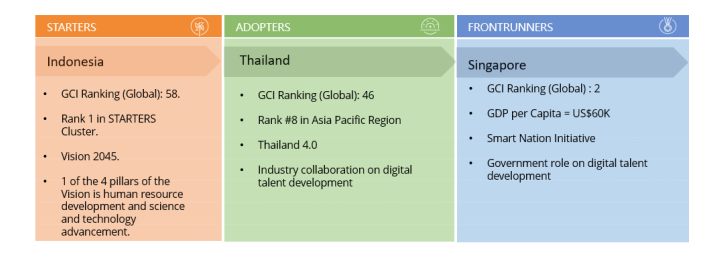2022 Asia Pacific digital talent insights
Over the next decade, emerging technologies such as 5G, cloud computing, big data, AI, IoT, and blockchain are poised to dramatically reshape the digital economy and impact the workforce.
As much as digital transformation will transform how people work, many job roles are becoming obsolete or require new skills. However, in some parts of Asia, it will take a little longer before the talent pool becomes available to fill these highly skilled jobs.
Highlighted in the picture are three GCI country clusters – starters, adopters, and frontrunners that differentiate between different levels of connectivity. The results demonstrate that economies with higher GCI scores have greater digital readiness.
The outlook will be determined by new technology adoption in the respective countries, their current level of skills gaps and how the demand for skills is expected to evolve.
Governments need to lead the way and work closely with industries and the academia (manpower supply) in terms of planning and developing their local talent.

Recently, the Asian Development Bank (ADB) estimated that 65 million jobs will be created annually in the Asia Pacific till 2025, resulting from the increased use of digital technologies amidst the COVID-19 pandemic.
IDC predicts that the digital economy will accelerate, with over 65% of APAC GDP expected to be digitalized and spending to hit US$1.2 trillion between 2020 and 2023.
As many of the Industries across Asia started embracing digital transformation to streamline operations to ensure businesses survival, there is a steep rise in demand for digital talents in emerging technologies.
Given the huge variety of industries in Asia Pacific, and the differing infrastructures from country to country, the pace of digital skilling is speeding up in the region, faster than in Europe and other parts of the world.
A key reason is that new technological advances take place much faster than decision makers define the approach or fully harness them.





